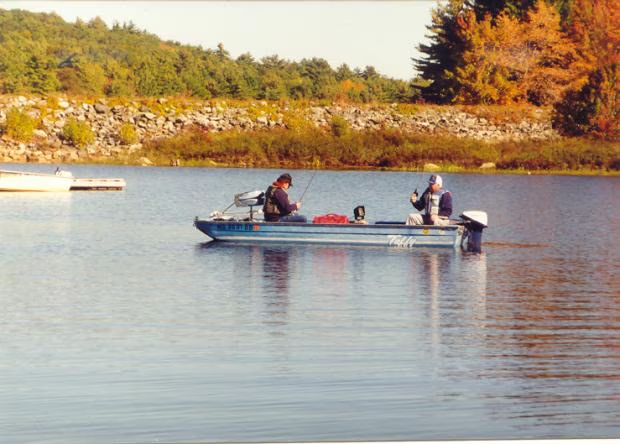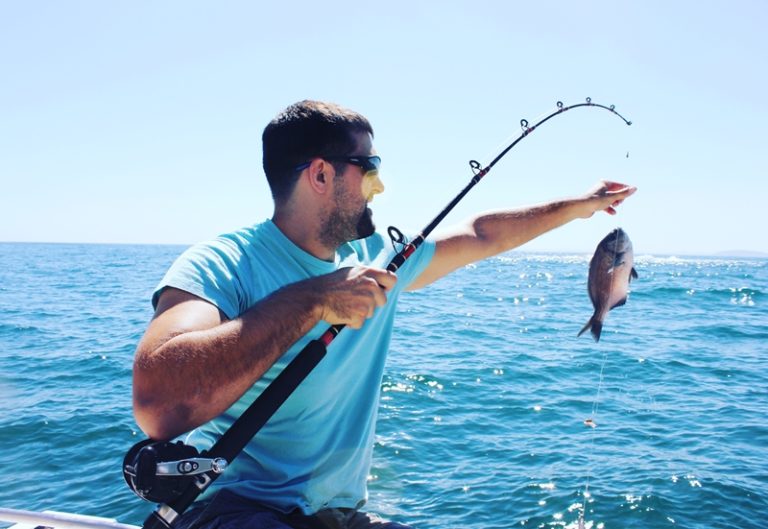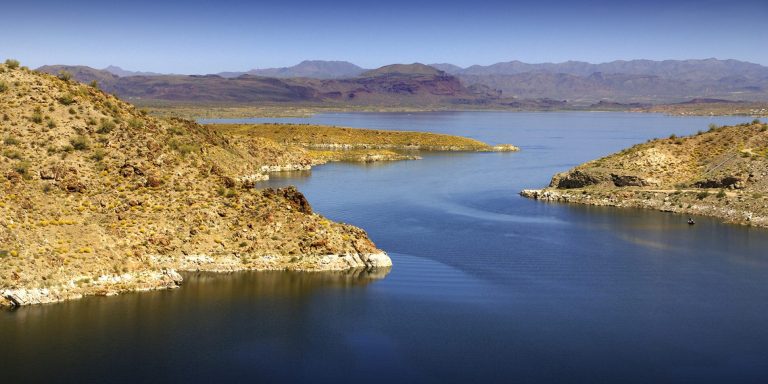Are you ready to cast your line and reel in some incredible catches? Look no further than the breathtaking fishing spots in Massachusetts!
From tranquil lakes in the Berkshires, perfect for bass fishing, to the expansive Connecticut River, teeming with trout, the Bay State truly offers an angler’s paradise. In this comprehensive guide, we will explore the top 5 fishing spots that promise thrilling experiences and unforgettable memories on the water:
- Quabbin Reservoir
- Connecticut River
- Wachusett Reservoir
- Onota Lake
- Housatonic River
Get ready to discover these prime locations where you can create lasting memories while enjoying your favorite pastime.
1. Quabbin Reservoir: A Trophy Trout Haven

Located in central Massachusetts, Quabbin Reservoir spans a remarkable 25,000 acres, making it one of the largest and most scenic fishing locations in the state. Renowned for its trophy-sized lake trout, many anglers report catches exceeding 20 pounds, drawing fishing enthusiasts from across the region.
In addition to lake trout, Quabbin is home to a diverse array of fish species, including:
- Smallmouth Bass
- Largemouth Bass
- Rainbow Trout
- Brown Trout
- White Perch
Accessing Quabbin Reservoir is convenient, with multiple entry points around its perimeter. Anglers can enjoy shoreline fishing or opt for boat rentals to explore deeper waters; however, all private boats must have an intact Quabbin Boat Seal (QBS) obtained through a decontamination process prior to launching. The optimal time for targeting lake trout is from April to November, with fishing permitted from the third Saturday in April until the third Saturday in October. Peak activity typically occurs between May and October.
Insider Tip: Local experts recommend using a combination of live bait—such as shiners—and lures like spoons and jigs for the best chance at landing trophy lake trout in Quabbin Reservoir.
When planning your fishing trip, it is crucial to familiarize yourself with specific regulations designed to protect this vital water supply and manage invasive species. Adhering to these guidelines ensures a sustainable fishery for future generations. For detailed information on fishing regulations and permits, visit the Massachusetts Division of Fisheries and Wildlife or check out Quabbin Reservoir’s official site.
2. Connecticut River: A Diverse Fishing Experience

The Connecticut River, flowing through the heart of New England, presents a rich tapestry of fishing opportunities suitable for anglers at all skill levels. This iconic river boasts a variety of fish species, including:
- Smallmouth Bass
- Largemouth Bass
- Northern Pike
- Walleye
- Channel Catfish
- Striped Bass (primarily in the lower river)
With year-round fishing available, the prime season typically spans from May to October. Anglers can conveniently access the river through numerous boat launches and fishing piers located along its banks.
A standout destination for fishing enthusiasts is the “Trophy Stretch” in Pittsburg, New Hampshire. This renowned section connects First Connecticut Lake with Lake Francis and is celebrated for its exceptional trout and salmon fishing. The cold, clear water released from the dam creates ideal conditions for these prized game fish.
Local guides recommend using streamers or nymphs when fly fishing the Trophy Stretch, as these patterns are particularly effective for targeting local trout and salmon populations.
When planning your fishing trip on the Connecticut River, it is crucial to familiarize yourself with specific regulations that apply to different sections of the river. For example, certain areas may have catch-and-release policies or specific creel limits that vary by species. For up-to-date information on regulations and to purchase necessary fishing licenses, visit Connecticut DEEP’s official website or Take Me Fishing.
3. Wachusett Reservoir: A Hidden Gem for Lake Trout

Wachusett Reservoir, situated in central Massachusetts, is a renowned fishing spot that provides exceptional opportunities for catching lake trout and various coldwater species. Spanning 4,135 acres, this reservoir opens its shores to anglers from dawn to dusk starting on the first Saturday in April through November 30, making it an ideal location for both seasoned fishermen and beginners alike. Note that ice cover may affect these dates, especially during winter months when access can be limited.
Anglers at Wachusett Reservoir can expect to encounter a diverse range of fish species, including:
- Lake Trout
- Smallmouth Bass
- Largemouth Bass
- Rainbow Trout
- Brown Trout
- Yellow Perch
To enhance your success when targeting lake trout at Wachusett Reservoir, consider these effective strategies:
- Focus on Deep Water: Target areas near steep drop-offs, points, and submerged structures where lake trout are likely to congregate.
- Bait Selection: Utilize a mix of live bait such as shiners and artificial lures like spoons and jigs to attract more fish.
- Timing is Key: Be patient and persistent; lake trout can be elusive. Early morning and late evening are often the most productive times for fishing.
Local anglers recommend these prime fishing hours because lake trout tend to be more active during these periods. Additionally, anglers are allowed to harvest up to three lake trout per day with no minimum size limit. For other species like rainbow trout, the daily limit is eight during certain seasons.
Before embarking on your fishing adventure, ensure you have obtained the necessary fishing permits. Familiarize yourself with specific regulations governing Wachusett Reservoir by visiting the official Massachusetts Fishing Guide for comprehensive information on rules and licensing requirements. Remember that fishing is prohibited in specific areas marked along Route 70 (Gates 6 to 17A), Route 140 (Gates 17 to 23), Route 12/110 (Gates 25 to 35), and West Boylston (Thomas Basin).
4. Onota Lake: A Berkshire Gem for Trout and Bass

Nestled in the picturesque Berkshires of western Massachusetts, Onota Lake spans 617 acres and presents excellent fishing opportunities for both coldwater and warmwater species. This lake is annually stocked with rainbow and brown trout by MassWildlife, ensuring exciting action for anglers throughout the spring and summer months. In fact, over 500 rainbow trout were recently released into the lake as part of ongoing stocking efforts.
In addition to the stocked trout, Onota Lake is home to a robust population of:
- Largemouth Bass
- Smallmouth Bass
- Yellow Perch
- Black Crappie
- Northern Pike
- Chain Pickerel
Onota Lake is open for fishing year-round, with ice fishing being particularly popular during winter months. Anglers can easily access the lake via a public boat launch located at Burbank Park or by casting from the shore at designated fishing piers that are accessible for all.
Local Expertise and Fishing Tips
Experienced anglers in the Berkshires recommend targeting trout during the spring and fall months when cooler water temperatures make fish more active. When fishing for trout at Onota Lake, consider using a combination of live bait—such as worms or minnows—and artificial lures like spinners or spoons. For bass fishing, effective strategies include casting crankbaits, soft plastics, or topwater lures near structures and weed beds.
Before embarking on your fishing adventure, ensure you obtain the necessary fishing permits through official channels and familiarize yourself with specific regulations for Onota Lake. For detailed information on fishing conditions and to purchase required licenses, visit the official (https://www.cityofpittsfield.org/departments/community_development/open_space_program/onota_lake.php) website or (https://www.mass.gov/info-details/barrier-free-fishing) page.
5. Housatonic River: A Premier Trout and Bass Destination

The Housatonic River, meandering through western Massachusetts and Connecticut, is renowned as a top-tier location for both trout and bass fishing. This picturesque river presents a variety of fishing experiences, ranging from fast-flowing riffles in its upper reaches to tranquil, deeper pools downstream.
A highlight for anglers is the Trout Management Area (TMA) in Connecticut. Stretching from the Massachusetts border to Cornwall’s Housatonic River Bridge, this segment is celebrated for its exceptional trout population. The TMA is stocked annually with thousands of rainbow and brown trout, ensuring thrilling fishing opportunities throughout the season. However, it’s important to note that fishing is prohibited from June 15 to September 15 due to high water temperatures that can be lethal for trout during warmer months.
Moreover, anglers can enjoy excellent catches of both smallmouth and largemouth bass in this river. These vigorous fish are typically found in deeper pools or near structures like rocks, logs, and undercut banks where they seek cover.
Insider Tip: Local guides recommend using streamers or nymphs when fly fishing here; these patterns have proven highly effective for targeting resident trout and bass populations. To find local guides, consider checking resources such as Housatonic River Outfitters or local fishing forums.
Before casting your line on the Housatonic River, it’s crucial to understand specific regulations applicable to your chosen section. The TMA enforces special rules aimed at conserving trout populations, including catch-and-release mandates and gear restrictions.
To enhance your fishing success on this river, consider hiring a local guide who can offer expert insights into optimal fishing spots and techniques. Additionally, you can consult resources like Housatonic River Outfitters’ hatch chart to select effective flies and lures based on seasonal insect activity.
For up-to-date information on fishing conditions and to obtain necessary licenses, visit the official Connecticut DEEP website where you can purchase licenses online or find local vendors.
Fishing Tips and Techniques
Maximize your fishing adventures in Massachusetts with these expert tips and techniques tailored for both freshwater and saltwater enthusiasts.
Freshwater Fishing Tips
- Use Live Bait: Enhance your chances of catching trout, bass, or other freshwater species by using live bait like worms, minnows, or crayfish.
- Experiment with Lures: Test various lures such as spinners, crankbaits, and soft plastics to determine the most effective options for your target fish and water conditions.
- Time Your Fishing: Early mornings and late evenings are prime times for freshwater fishing, as fish are most active during these cooler periods. In spring, target pre-spawn bass in shallow waters where they feed heavily before spawning.
Saltwater Fishing Tips
- Choose Durable Gear: Equip yourself with corrosion-resistant reels and rods, and opt for braided lines to withstand the challenging saltwater environment.
- Monitor Tides: Plan your trips around changing tides; fish activity peaks during these times as they follow prey into shallower waters.
- Target Structures: Focus on areas like reefs, wrecks, and drop-offs where saltwater fish often gather; these structures provide shelter and feeding opportunities.
Optimal Fishing Times
Fishing success in Massachusetts depends on the water body and species; general guidelines include:
- Early Morning: Cooler temperatures make this a productive time, especially in summer when fish are more active.
- Late Evening: As the day cools down, fish often become more active; this is an excellent time to cast your line.
- Overcast Days: Reduced light levels encourage fish activity throughout the day; cloudy weather can lead to successful catches.
Essential Gear Recommendations
Prepare for your fishing trip with the right equipment:
- Rod and Reel: For freshwater, a medium-action rod with a spinning reel is versatile. For saltwater, choose a heavier rod paired with a corrosion-resistant reel suitable for larger species like striped bass or cod.
- Fishing Line: Use monofilament for freshwater applications; braided lines are preferred for saltwater due to their strength and durability against harsh conditions.
- Lures and Bait: Stock up on spinners, crankbaits, soft plastics, worms, minnows, and shrimp to match your target species’ preferences. For bass fishing specifically, consider using jerk baits during spring or topwater lures during summer evenings.
By following these tips and equipping yourself with the right gear while adhering to local regulations—such as size limits for striped bass (28″ minimum) or seasonal restrictions—you can enhance your fishing experience while contributing to sustainable practices that protect our fisheries.
With this comprehensive guide, you’re now equipped with the knowledge and resources to embark on an unforgettable fishing adventure in Massachusetts. Whether you’re a seasoned angler or a beginner, the Bay State’s diverse waters offer something for everyone. So, grab your gear, secure your fishing licenses, and get ready to create lasting memories on the water!








